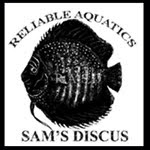Sunday, August 22, 2010
Saturday, April 17, 2010
WHAT IS DISCUS FISH ?
| Scientific classification | |
|---|---|
| Kingdom: | Animalia |
| Phylum: | Chordata |
| Class: | Actinopterygii |
| Order: | Perciformes |
| Family: | Cichlidae |
| Subfamily: | Cichlasomatinae |
| Tribe: | Heroini |
| Genus: | Symphysodon Heckel, 1840 |
Discus (Symphysodon spp.) are a genus of three species of cichlid freshwater fishes native to the Amazon Riverbasin[1]. Discus are popular as aquarium fish and their aquaculture in several countries in Asia is a major industry.
Taxonomy
Discus belong to the genus Symphysodon, which currently includes three species: The common discus(Symphysodon aequifasciatus), the Heckel discus (Symphysodon discus), and a new species which has been namedSymphysodon tarzoo.] However, a further investigation published in August 2007 [7] suggested that the genus held the three species: S. aequifasciatus (the green discus), S. haraldi (the blue/brown/common discus) and S. discus (the Heckel discus). Both studies suggest three species; the only disagreement is in the scientific names for each.
Appearance
Like cichlids from the genus Pterophyllum, all Symphysodon species have a laterally compressed body shape. In contrast to Pterophyllum, however, extended finnage is absent giving Symphysodon a more rounded shape. It is this body shape from which their common name, “discus”, is derived. The sides of the fish are frequently patterned in shades of green, red, brown, and blue. The height and length of the grown fish are both about 20–25 cm (8–10 in).
Reproduction and sexual dimorphism
Another characteristic of Symphysodon species is their care for the larvae. As for most cichlids, brood care is highly developed with both the parents caring for the young. Additionally, adult discus produce a secretion through their skin, which the larvae live off during their first few days. This behaviour has also been observed for Uaruspecies. However when bred in captivity the larvae will tend to live off their parents secretion for up to 2 weeks.
Distribution
The three species of Symphysodon have different geographic distributions. S. aequifasciatus occurs in the Rio Solimões, Rio Amazonas and the Río Putumayo-Içá in Brazil, Colombia and Peru. In contrast the distribution of S. discus appears to be limited to the lower reaches of the Abacaxis, Rio Negro and Trombetas rivers. S. tarzoo occurs upstream of Manaus in the western Amazon.
Subscribe to:
Comments (Atom)

